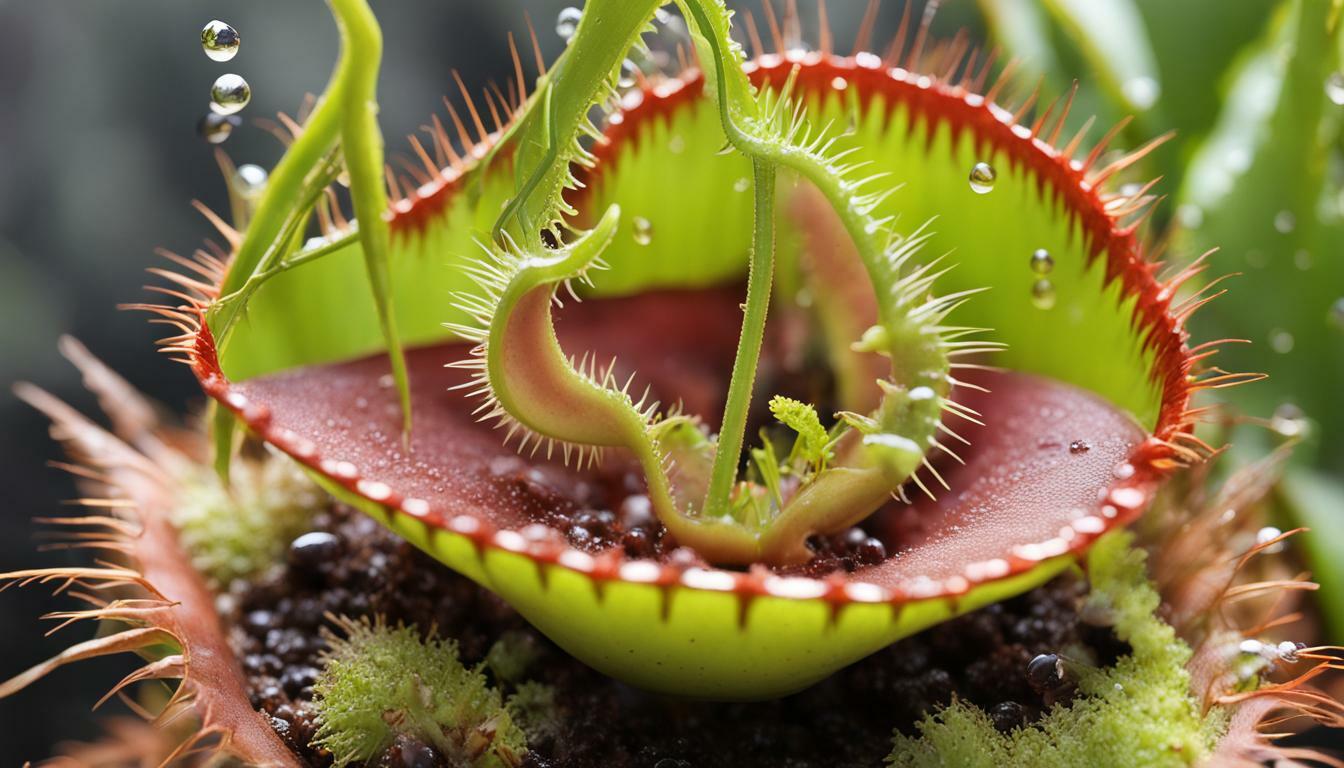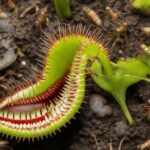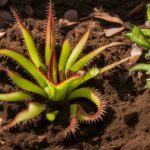Venus flytraps are fascinating carnivorous plants that garner attention for their unique ability to catch and digest prey, primarily insects and spiders. But how do you know when your Venus flytrap is hungry?
There are several signs that indicate a Venus flytrap is in need of a meal. One of the most obvious signs is closed traps. When a Venus flytrap is hungry, it will close its traps in an attempt to catch prey. If you notice that your Venus flytrap’s traps are closed and there is no prey inside, it’s likely time for a feeding.
Another sign that your Venus flytrap is hungry is the lack of prey remains in its traps. After a Venus flytrap has caught and digested prey, it will leave behind small, black remains inside the trap. If you do not see any remains, it’s possible that your Venus flytrap needs a meal.
Lastly, a hungry Venus flytrap may exhibit reduced growth. Without a steady diet of insects, the plant will not receive the necessary nutrients to grow and thrive. If you notice that your Venus flytrap is not growing as it should, it may be time to feed it.
Key Takeaways:
- Closed traps on a Venus flytrap indicate hunger.
- The lack of prey remains in a trap can signal that it’s time for a feeding.
- If a Venus flytrap is not growing as it should, it may need to be fed.
- Understanding the signs of a hungry Venus flytrap is important for providing it with proper care.
Understanding the Venus Flytrap’s Appetite
As a carnivorous plant, Venus flytraps have a unique feeding behavior that sets them apart from other plants. Understanding their appetite and feeding habits is crucial for their growth and well-being.
Venus flytraps are capable of catching and digesting insects, spiders, and other small invertebrates to supplement their nutrient intake. However, they do not require frequent feeding, and overfeeding can actually harm the plant.
The ideal feeding schedule for Venus flytraps depends on their growth stage and the availability of prey. During the growing season, which typically lasts from spring to early fall, Venus flytraps should be fed every 1-2 weeks. However, during the dormant period, they may only need to be fed once a month or less.
It is important to note that Venus flytraps can only consume live prey that is within a certain size range. Prey that is too large can damage the plant, while prey that is too small may not provide enough nutrients.
When feeding your Venus flytrap, use tweezers to place the prey directly onto the trigger hairs inside the trap. Be patient, as it may take several days for the trap to close completely. Once the trap has closed, do not disturb the plant, as this can cause it to release digestive enzymes prematurely.
By following a proper feeding schedule and providing suitable prey, you can help ensure the vitality and longevity of your Venus flytrap.
Recognizing Hunger in Venus Flytraps
Venus flytraps are fascinating plants that survive by trapping and digesting insects. However, to do so, they require a specific diet and feeding schedule. Here are some signs that your Venus flytrap is hungry and needs to be fed.
| Hungry Venus Flytrap Symptoms | |
|---|---|
| 1. Closed traps: | If your Venus flytrap’s traps are closed, it is a sign that it has digested its previous meal and is ready for a new one. |
| 2. Lack of prey remains: | If you do not see any insect remains in your Venus flytrap’s traps, it means that it has not caught anything recently and is hungry. |
| 3. Reduced growth: | If your Venus flytrap is not growing as fast as it used to, it may be a sign that it is not getting enough nutrients from its current diet. |
Feeding a hungry Venus flytrap is crucial for its health and well-being. Here are some tips on how to feed your Venus flytrap.
- Choose the right prey: Venus flytraps feed on live insects, such as flies, ants, and spiders. Avoid feeding it anything that is too big or too small for its traps to handle.
- Do not overfeed: Venus flytraps should be fed one or two insects at a time. Overfeeding can cause the traps to become too small to catch prey.
- Feed at the right time: Venus flytraps are most active during the summer months. This is the best time to feed them, as they will have plenty of energy to digest their food.
- Use the right technique: When feeding your Venus flytrap, make sure to place the insect inside the trap and not on top of it. This will ensure that the trap closes properly and the insect is digested.
By recognizing the signs of a hungry Venus flytrap and feeding it appropriately, you can ensure that your plant stays healthy and continues to thrive.
Feeding Your Venus Flytrap
Feeding your Venus flytrap is an important part of its care routine. While these plants can capture their own prey, it’s essential to supplement their diet in order to ensure healthy growth and longevity. Here are some tips to help you feed your Venus flytrap effectively:
Choose Suitable Prey
Venus flytraps are carnivorous plants that require live prey to survive. The most suitable prey options for Venus flytraps are insects such as flies, spiders, and ants. Make sure to avoid feeding your Venus flytrap anything larger than one-third the size of the trap and refrain from feeding them any meat or dairy products, which they aren’t able to digest.
Proper Feeding Techniques
When feeding your Venus flytrap, it’s important to ensure that the prey is properly placed in the center of the trap. Gently brush the prey against the trigger hairs of the trap and avoid touching the trigger hairs with your fingers or any tools. This will prevent the trap from closing prematurely and potentially damaging the plant.
Venus Flytrap Care Tips
After feeding your Venus flytrap, it’s important to avoid triggering the traps for at least 12 hours to allow the digestive process to begin. Additionally, make sure to provide your Venus flytrap with plenty of sunlight and keep the soil moist at all times. Avoid using tap water, as the chemicals can harm the plant. Instead, use distilled or rainwater.
Following these tips will help you ensure that your Venus flytrap is well-fed and healthy. With proper care, your Venus flytrap can thrive and continue to impress with its unique carnivorous nature.
Establishing a Feeding Schedule
When it comes to feeding your Venus flytrap, establishing a feeding schedule is crucial to its health. The frequency of feeding depends on the age and size of the plant, as well as the availability of prey.
For juvenile Venus flytraps, it’s best to feed them once every 1-2 weeks, while mature plants can be fed once every 2-4 weeks. During the winter months, when the plant enters a dormant phase, feeding can be reduced or stopped altogether.
It’s important to note that overfeeding can be detrimental to the plant’s health, so it’s crucial to avoid overfeeding. If you notice that your Venus flytrap is not growing as quickly as it should or that the traps are not closing as tightly as before, it may be a sign that it’s being overfed.
It’s also important to time feeding carefully. Venus flytraps are most active in the morning and early afternoon, so it’s best to feed them during this time. Avoid feeding them at night or in low-light conditions, as this can disrupt their natural feeding rhythm.
By establishing a feeding schedule that takes into account the plant’s growth cycle and natural feeding habits, you can ensure that your Venus flytrap is healthy and thriving.
Conclusion
In conclusion, taking care of your Venus flytrap’s appetite is crucial to its health and growth. By recognizing the signs of hunger and providing it with a suitable diet, you can ensure that your plant thrives. Remember to feed your Venus flytrap with appropriate prey, such as insects, and to avoid overfeeding it, which can lead to digestive problems. Establishing a feeding schedule that takes into account the plant’s growth cycle and seasonal changes is also important. By following these guidelines, you can enjoy the fascinating carnivorous nature of your Venus flytrap for years to come.Can a Venus Flytrap Feel Hunger?
The venus flytrap and its emotions have long been a subject of scientific curiosity. While these carnivorous plants lack a centralized nervous system, recent research suggests they may exhibit a primitive form of hunger. When triggered by the presence of prey, the plant’s specialized hairs send electrical signals, indicating a response resembling hunger. Further exploration is needed to unravel the mysterious world of the Venus flytrap’s emotions.
FAQ
Q: How do you know if a Venus flytrap is hungry?
A: Signs of a hungry Venus flytrap include closed traps, lack of prey remains, and reduced growth.
Q: What is the natural diet of a Venus flytrap?
A: Venus flytraps primarily feed on insects and other small arthropods.
Q: How often should I feed my Venus flytrap?
A: Venus flytraps should be fed every 1-2 weeks, depending on their growth cycle and seasonal variations.
Q: What are suitable prey options for feeding a Venus flytrap?
A: Suitable prey options for Venus flytraps include small flies, ants, and other insects that fit within their traps.
Q: How should I feed my Venus flytrap?
A: When feeding your Venus flytrap, gently place the prey inside the trap and avoid triggering it with your fingers.
Q: Should I force-feed my Venus flytrap if it doesn’t catch prey on its own?
A: It’s best not to force-feed a Venus flytrap. It should primarily rely on catching prey naturally.











